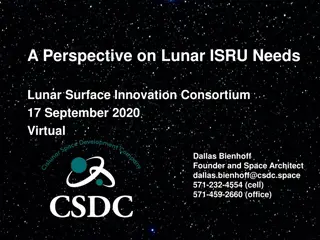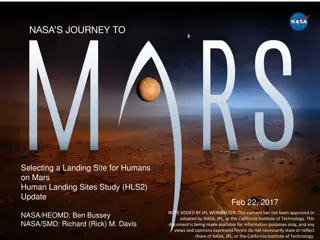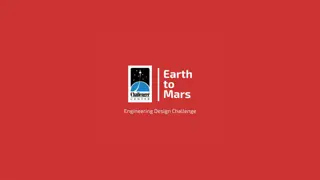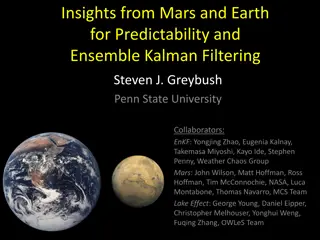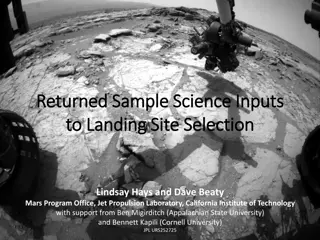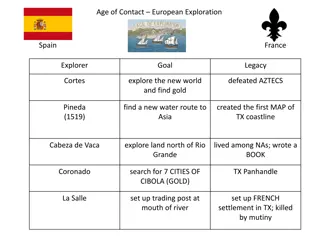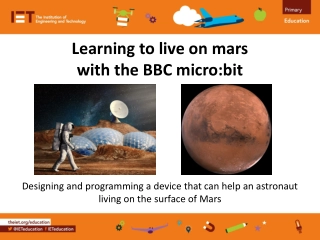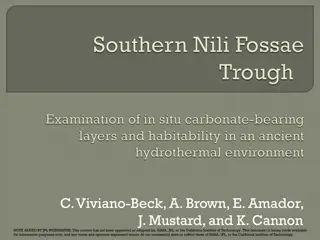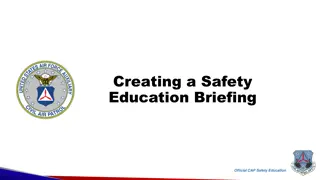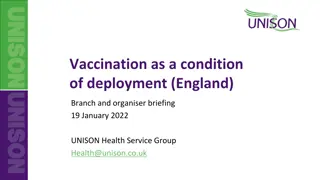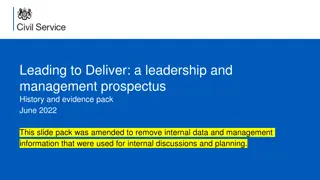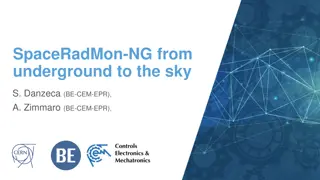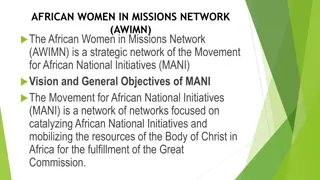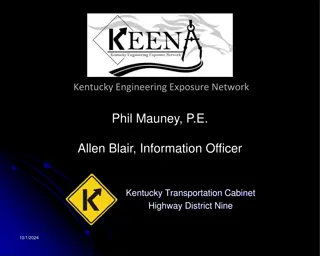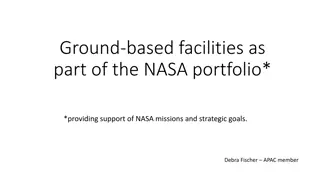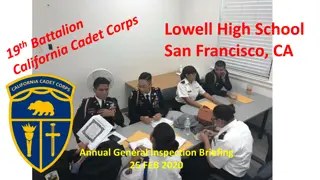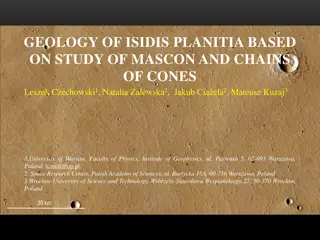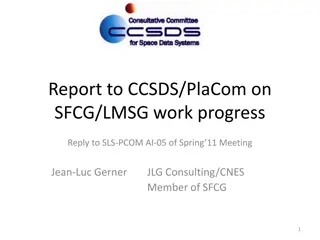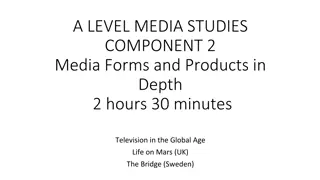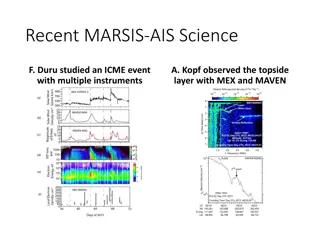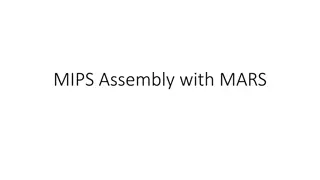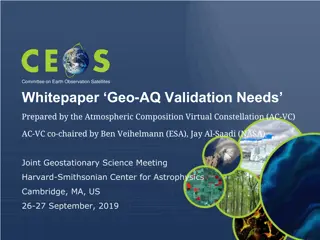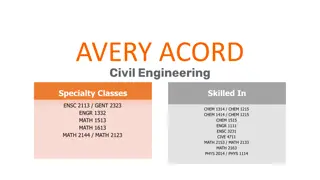ISRU & Civil Engineering Needs for Future Human Mars Missions Briefing
This briefing discusses the ICE Working Group's purpose, membership, and tasks related to identifying capabilities and resources essential for establishing a sustainable human presence on Mars. It outlines the criteria for site selection and the data sets required to support human surface missions on the red planet.
Download Presentation

Please find below an Image/Link to download the presentation.
The content on the website is provided AS IS for your information and personal use only. It may not be sold, licensed, or shared on other websites without obtaining consent from the author. Download presentation by click this link. If you encounter any issues during the download, it is possible that the publisher has removed the file from their server.
E N D
Presentation Transcript
ISRU & Civil Engineering Needs for Future Human Mars Missions Briefing for First Landing Site/Exploration Zone Workshop for Human Missions to the Surface of Mars 27 October 2015 Steve Hoffman
Contents ICE WG Purpose ICE WG Membership ICE WG Meeting Schedule and Presentation Topics Assumptions ISRU and CE Objectives for Site Selection ISRU and CE Site Criteria: Threshold ISRU and CE Site Criteria: Qualifying ISRU & Civil Engineering Working Group Pre-decisional, for Planning Purposes Only September 2015 2
ICE WG Purpose The purpose for the ICE WG is: 1. Identify capabilities and resources that will be key to establishing a sustainable human presence on Mars; 2. Characterize activities that must be carried out on the surface of Mars in order to advance these capabilities to a level where they can be relied upon without routine support from Earth; 3. Describe the characteristics (e.g., concentration of targeted mineral types, slopes, rock size distribution, overburden depth of targeted mineral types, etc.) of Mars surface sites that are necessary to support this capability advancement. 4. Describe the data sets needed to support site selection to support human surface missions ISRU & Civil Engineering Working Group Pre-decisional, for Planning Purposes Only September 2015 3
ICE WG Membership Member Name Center/ Institution Working Group Co-Chairs Johnson Space Center (Science Applications International Corp) Kennedy Space Center Stephen Hoffman, PhD Rob Mueller User Communities Representatives Marshall Space Flight Center (Gray Research, Inc.) Johnson Space Center Johnson Space Center Jet Propulsion Laboratory Langley Research Center Jet Propulsion Laboratory Johnson Space Center New Mexico State University Johnson Space Center Johnson Space Center Johnson Space Center Solar System Exploration Research Virtual Institute (SSERVI) Kennedy Space Center Jet Propulsion Laboratory Brand Griffin John Gruener Don Henninger, PhD Scott Howe, PhD Chris Jones Laura Kerber, PhD Doug Ming, PhD Jim Murphy, PhD Paul Niles, PhD Michelle Rucker Jerry Sanders Laurent Sibille, PhD Ray Wheeler, PhD Brian Wilcox Ex Officio Ben Bussey, PhD Rick Davis NASA HQ / HEOMD NASA HQ / SMD ISRU & Civil Engineering Working Group Pre-decisional, for Planning Purposes Only September 2015 4
Charter Tasks Detailed Flow & Schedule Week 4/13 Week 4/20 Week 4/27 Week 5/4 Week 5/11 Week 5/18 Week 5/25 Week 6/1 Weeks 6/8-6/29 ICE WG start 1 1 1 1 2 2 4 4. Data sets required 1 2 3 2 2 2 4 3 4 2 3 2 3 4 July 1 1. What capabilities and resources? Team comprised of whole committee less below Draft complete PPT Week 5/25 First 2. What site selection criteria? Team comprised of 4 persons Draft PPT 4. What data sets are required Team comprised of whole committee, less #5, separated into sub-teams Sept 30 Final word doc & PPT Week 6/1 Report to HLS2 3. Communicate with interested groups? Team comprised of ~2 persons background, to include whole committee in final week DRAFT - Predecisional 5
Human Missions to Mars: Current Planning Current planning for human Mars missions (commonly referred to as the Evolvable Mars Campaign or EMC) is different from DRA 5.0 DRA 5.0: Three missions lasting ~500 sols on the ground to three different locations with a crew of 6 EMC: a single surface site will be visited by multiple crews (total number is TBD) for durations ranging from ~300 sols to ~500 sols Both scenarios assume that small pressurized rovers that allow the crews to venture to distances of ~100 km from their base for durations of ~14 sols The EMC has taken on the added objective of learning how to live and work on Mars for extended periods, including infrastructure improvements using local resources and gradually breaking the logistical chain with Earth As a consequence of visiting the same site by multiple crews, site selection takes on added significance to maximize the potential for on-going scientific research and gradually breaking the logistical chain with Earth DRAFT - Predecisional
ISRU and CE Objectives for Mars Surface Mission Demonstrate the ability to prospect for and extract useful commodities from local materials in a cost effective and sustainable fashion and begin using those commodities in nominal operations as soon as possible Highest priority: water Secondary priority: metals, structural building materials Rationale: water can be used for multiple purposes that are mission enhancing or enabling (propellant/fuel cell reactant production, life support, radiation shielding, plant growth). Metals will be important for in-situ fabrication of spare parts and repairs. Oxygen, buffer gases and carbon dioxide are obtained from the atmosphere Demonstrate the ability to manipulate the surface for infrastructure emplacement and protection of hardware Highest priority: foundation improvement and surface stabilization (including landing pads, roads, berms, etc.) Secondary priority: structures, radiation shielding Rationale: Each candidate site will exhibit strengths and weaknesses. For example, landing plume cratering may be significant if the site has substantial amounts of loose surface material or lacks any exposed bedrock; cratering must be adequately addressed to remove the concern. Berms and roads may be required to minimize mobility maintenance and allow for consolidation of delivered infrastructure. While very important, radiation shielding may be enhanced using water walls before surface material is required. Thus each candidate site will be assessed for factors such as these and an overall site plan will be developed noting where improvements are required. Demonstrate capabilities that reduce reliance on supplies from Earth using indigenous materials, resources, and the environment Highest priority: food production Rationale: one of the largest (the largest?) consumable items that must be imported from Earth in current mission scenarios Secondary priority: in-situ manufacturing and construction with in-situ derived feedstock Rationale: To minimize long term costs, logistics, and risk to crew DRAFT - Predecisional
ISRU and CE site criteria: threshold (i.e., must have) 1/4 The Exploration Zone must show potential for at least one water resource feedstock Feedstock can be either water ice, ice/regolith mix, or hydrated minerals Potential for hydrated minerals with a high concentration (greater that 5% by weight) Rationale: Based on maintaining same power infrastructure as atmosphere only processing) Potential for ice or ice/regolith mix Desired resolution for mineral and water content <100 m desired, <1000 m required Resource feedstock deposit must allow for initial mission use and long term surface operations. Single primary water resource must be sufficient to support radiation shielding, life support, EVA, and propulsion needs for several human missions Rationale: ~20000 kg required for each Mars ascent, initial radiation shielding, EVA support, and crop growth Resource feedstock must be in a form that is minable by systems that are highly automated Rationale: The feedstock deposit is preferred to be in a form that is easily excavated. Mining equipment or techniques requiring extensive crew time to operate or to supervise is highly unlikely. DRAFT - Predecisional
ISRU and CE site criteria: threshold (i.e., must have) 2/4 The Exploration Zone must show potential for at least one water resource feedstock (continued) Initial resource feedstock located within 1-3 km (TBR) of ISRU processing plant and power infrastructure Terrain features must not prevent direct-line-of-site communications between ISRU processing system and rover/excavators if possible (adds need for communication repeaters) Rationale: resource economics decreases with increased distance (i.e., transportation costs) from processing point or utilization point; Risk in initial mission operations and product availability require initial resources to be nearby and located outside of natural deep features such as canyons, deep craters (note: lava tubes are not excluded) Resource feedstock located within 0-1 meters (TBR) of surface Rationale: resource economics decreases with increased cost to excavate feedstock. Deeper than 1 meter requires extensive removal of overburden and/or multiple segment drill. Also depth penetration of neutron spectrometers is typically <1 m Resource feedstock located in accessible location Sufficiently flat to permit excavation and soil storage <10 (TBD based on rover stability and loading design) Major natural obstacles along the most direct traverse between resource feedstock and usage area must not be present that exceed planned mining mobility platforms such as canyons, cliffs, vertical outcrops, and wide crevices Rock size must not allow impact to rover mobility <30 cm (TBD based on rover clearance) Rock distribution must not allow for impact to excavation operations DRAFT - Predecisional
ISRU and CE site criteria: threshold (i.e., must have) 3/4 Access to at least one region where infrastructure construction can be emplaced or constructed Flat and stable terrain with sparse rock distribution An area of at least (approximately) 25 sq km (TBR) with these characteristics: Slope less than 10 deg (on a TBD baseline TBR) over at least 60% (TBR) of this area Rock distribution (need descriptor similar to slope: a specified characteristic over some TBD fraction of the area) Exposed bedrock or soil/regolith bulk density greater than (TBD) over at least 40% (TBR) of this area No indication (or minimal indication?) of seasonal changes over at least 60% (TBR) of this area Rationale: flat terrain and sparse rock distribution minimizes amount of terrain modification required prior to infrastructure construction. Bedrock for safer landing and strong foundation for infrastructure Rationale: stable terrain required for adequate foundation Located within 5 km (TBR) of landing site location Rationale: minimizes transportation requirements DRAFT - Predecisional
ISRU and CE site criteria: threshold (i.e., must have) 4/4 The Exploration Zone must show potential for metal/silicon resources Resources of primary interest are iron, aluminum, and silicon; titanium and magnesium are of secondary interest. (see table on next page) Mineral resources should be near surface 1 to 2 meters: Rationale: Allowable depth is 1 to 2 meters based on limitations in sampling technique and economics of extraction. Deeper resources will require higher concentrations, but are allowed due to the smaller quantity of resource required. Terrain guidelines same as for water resources; can be relaxed for resource evaluation purposes only. Resource feedstock must be in a form that is minable by systems that are highly automated. Rationale: The feedstock deposit is preferred to be in a form that is easily excavated. Mining equipment or techniques requiring extensive crew time to operate or to supervise is highly unlikely. DRAFT - Predecisional
ISRU and CE site criteria: qualifying (enhancements to threshold) 1/4 The Exploration Zone should have potential for multiple sources of water resources Feedstock can be combination of water ice, ice/regolith mix, and/or hydrated minerals Concentrations should be greater than 5% by weight to justify extended range operations from processing location or from point of use Visual and/or remote sensing evidence of level of hydration or presence of ice and associated minerals Resource feedstock can be located >5 km (TBR) from processing location or from point of use Rationale: distance allowed will be a function of resource concentration and desire to evaluate different forms of water resources Resource feedstock located within 0-3 meters (TBR) of surface Rationale: Allowable depth of resource will be a function of resource concentration and desire to evaluate different forms of water resources. Resource feedstock located in accessible location Same as previous requirements Terrain guidelines can be relaxed to those of robotic and human mobility system capabilities for water resource evaluation only purposes DRAFT - Predecisional
ISRU and CE site criteria: qualifying (enhancements to threshold) 2/4 The Exploration Zone should have potential for multiple sources of water resources (continued) Distance between resource location and Consolidation location must be traversable Rock size must not allow impact to rover mobility <30 cm (TBD based on rover clearance) A plausible traverse route must be evident (Detailed assessments of traversability will be conducted separately) Surface material at these locations must allow for repeated rover operation over same spot without concern for wheel slippage/sinking Terrain features must not prevent direct-line-of-site communications between ISRU processing system and rover/excavators if possible (adds need for communication repeaters) Slopes, rock size/distribution, and soil properties should allow for road/path construction between resource excavation location and centralized ISRU processing systems if required for sustained use DRAFT - Predecisional
ISRU and CE site criteria: qualifying (enhancements to threshold) 3/4 From civil engineering Northern hemisphere <40 latitude Rationale: less extreme climate variations and higher solar flux Evidence for access to an abundant source of cobble sized [64-256 mm (2.5-10 in)] or smaller rocks and bulk, loose regolith Rationale: raw material (e.g., sand, cobbles, bulk regolith) for a variety of construction techniques such as leveling roadways, enhancing roadway surfacing, constructing berms, burying habitats for radiation protection, etc. Natural terrain features in close proximity to the landing site that can be used for radiation protection or other civil engineering enhancements Examples: shallow depressions, narrow (but accessible) valleys, lava tubes, etc.) DRAFT - Predecisional
ISRU and CE site criteria: qualifying (i.e., enhancements to threshold) 4/4 From food production Low latitude Rationale: more consistent lighting throughout the year No local terrain feature(s) that could shadow light collection facilities Rationale: Gathering natural light for crop production could be a significant efficiency improvement over all artificial lighting Access to water (preferable water ice to minimize processing) Access to dark, minimally altered basaltic sands Rationale: For use as soil base for crop growth; augmented with other material to improve crop growing potential Quantity is estimated at 32 m3 Avoid heavily weathered and/or altered soils (e.g., hydrothermal or fumarolic vent/system) Rationale: Using local materials as a soil base for crop growth is highly desirable but heavily weathered and/or altered soils have been shown by MER to be more deficient in plant essential nutrients DRAFT - Predecisional
BOE for water quantity requirement The 100 MT of water was an estimate based on several factors and intended to give various groups an indication of the magnitude of water human crews could reasonably expect to need and use. This value was based on an expert opinion estimate by a group that has been working this problem for many years. We know that each crew will need: propellant for its ascent vehicle, coolant for EVAs, radiation protection (and possibly construction), and for crop growth (if we expand into truly Earth-independent operations) Each ascent vehicle needs an estimated 20 MT of methane and LOX propellant (based on current designs). If water is used to make these propellants then you need approximately 10 MT of water for each crew. Cooling water will depend on the number of EVAs so this is difficult to quantify, but could be many tons per crew. Water is a good moderator of SPE and GCR radiation sources and improves with thickness. We have not finalized habitat designs but we do expect to use water walls on the habitat and the small pressurized rovers to protect the crews. This is a one-time quantity that we need and will depend on the habitat geometry but the magnitude is likely to be many tons. If we use water as a construction material, as has been proposed by recent NASA Centennial Challenge winners, we will need quite a lot. Finally, crop growth will need water proportional to the amount of food we decide to grow. This water can probably be recycled, so it may be a one-time amount just like the radiation protection. crop growth is likely to start small and increase over time as we gain experience with crops on Mars. So the quantity needed will grow over time. To come up with a total quantity needed we picked 5 crews as a reasonable number of crews we could expect to use a Mars surface base it could be more but probably not less, given the investment we are likely to put into this facility. When we added up our estimates in each of the categories described above we came up with an amount in the 80 MT range. We decided to give ourselves some margin for things we forgot and likely inefficiencies/losses in the processes that turn an amount of water on the surface into water the crew could use. DRAFT - Predecisional
ISRU Examples and Analogies Excavation rates required for 10 MT O2/yr production range based on extraction efficiency of process selected and location H2 reduction at poles (~1% efficiency): 150 kg/hr CH4 reduction (~14% efficiency): 12 kg/hr Electrowinning (up to 40%): 4 kg/hr Cratos & LMA rovers: 10 to 20 kg/bucket in <5 min.at field test in Hawaii Robotic Mining Challenges: 2009: 437 kg in 30 min.; remote operation 2015: 118 kg in 20 min; autonomous operation Soil Processing ROxygen: 5-10 kg/hr PILOT: 4.5-6 kg/hr Pioneer SBIR: 4 kg/hr MISME: 0.2 kg/hr Excavation rates required for 14.2 MT H2O/mission production range based on water content Hydrated soil (3%): 41 kg/hr Icy soil (30%): 4 kg/hr 14.2 MT of water per mission requires excavation of a Football field to a depth of 1.1 to 9.6 cm! (30% to 3% water by mass) 10 MT of oxygen per year requires excavation of a Soccer field to a depth of 0.6 to 8 cm! (14% to 1% efficiencies) DRAFT - Predecisional
How much Martian basaltic sands for a Mars greenhouse? Assume 40 m2 of plant growth area per person for 80% of required food (based on previous studies) For a crew of four: 160 m2 of plant growth area required Assume 10 cm deep plant growth trays: 16 m3 of sands required (565 ft3, 21 yd3) Assume sand bulk density = 1300 kg/m3 20.8 mt of sands required to supply 80% of required food for a crew of four DRAFT - Predecisional
Summary For ISRU and Civil Engineering purposes, we are looking for Resources Primarily water; secondarily metals and other mineral Construction materials Soil and water for crop growth Relatively flat area, relatively free of difficult terrain or hazards, and in a relatively compact area Will need the ability to establish the quantity and quality of the resource feedstock From orbit to the greatest extent possible On the surface with the minimum number of landed missions Depth estimate will be part of this process for both orbital and surface missions DRAFT - Predecisional



